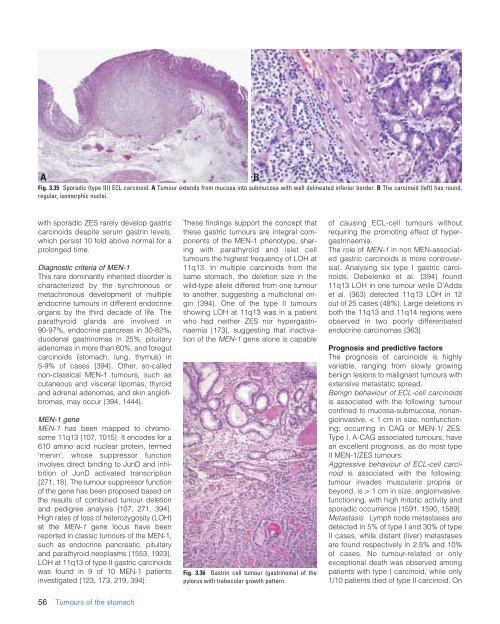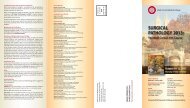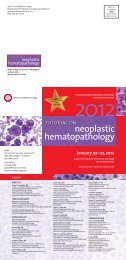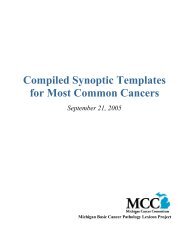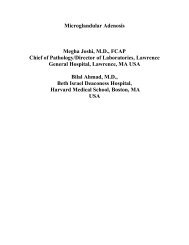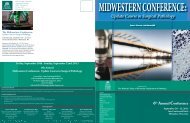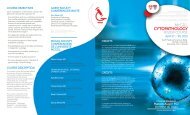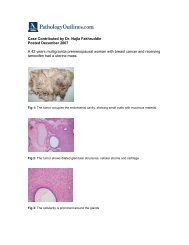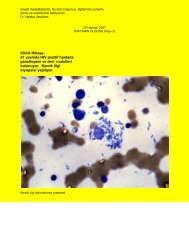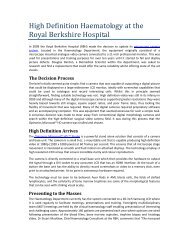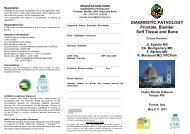CHAPTER 3 Tumours of the Stomach - Pathology Outlines
CHAPTER 3 Tumours of the Stomach - Pathology Outlines
CHAPTER 3 Tumours of the Stomach - Pathology Outlines
You also want an ePaper? Increase the reach of your titles
YUMPU automatically turns print PDFs into web optimized ePapers that Google loves.
A<br />
B<br />
Fig. 3.35 Sporadic (type III) ECL carcinoid. A Tumour extends from mucosa into submucosa with well delineated inferior border. B The carcinoid (left) has round,<br />
regular, isomorphic nuclei.<br />
with sporadic ZES rarely develop gastric<br />
carcinoids despite serum gastrin levels,<br />
which persist 10 fold above normal for a<br />
prolonged time.<br />
Diagnostic criteria <strong>of</strong> MEN-1<br />
This rare dominantly inherited disorder is<br />
characterized by <strong>the</strong> synchronous or<br />
metachronous development <strong>of</strong> multiple<br />
endocrine tumours in different endocrine<br />
organs by <strong>the</strong> third decade <strong>of</strong> life. The<br />
parathyroid glands are involved in<br />
90-97%, endocrine pancreas in 30-82%,<br />
duodenal gastrinomas in 25%, pituitary<br />
adenomas in more than 60%, and foregut<br />
carcinoids (stomach, lung, thymus) in<br />
5-9% <strong>of</strong> cases {394}. O<strong>the</strong>r, so-called<br />
non-classical MEN-1 tumours, such as<br />
cutaneous and visceral lipomas, thyroid<br />
and adrenal adenomas, and skin angi<strong>of</strong>ibromas,<br />
may occur {394, 1444}.<br />
MEN-1 gene<br />
MEN-1 has been mapped to chromosome<br />
11q13 {107, 1015}. It encodes for a<br />
610 amino acid nuclear protein, termed<br />
‘menin’, whose suppressor function<br />
involves direct binding to JunD and inhibition<br />
<strong>of</strong> JunD activated transcription<br />
{271, 18}. The tumour suppressor function<br />
<strong>of</strong> <strong>the</strong> gene has been proposed based on<br />
<strong>the</strong> results <strong>of</strong> combined tumour deletion<br />
and pedigree analysis {107, 271, 394}.<br />
High rates <strong>of</strong> loss <strong>of</strong> heterozygosity (LOH)<br />
at <strong>the</strong> MEN-1 gene locus have been<br />
reported in classic tumours <strong>of</strong> <strong>the</strong> MEN-1,<br />
such as endocrine pancreatic, pituitary<br />
and parathyroid neoplasms {1553, 1923}.<br />
LOH at 11q13 <strong>of</strong> type II gastric carcinoids<br />
was found in 9 <strong>of</strong> 10 MEN-1 patients<br />
investigated {123, 173, 219, 394}.<br />
These findings support <strong>the</strong> concept that<br />
<strong>the</strong>se gastric tumours are integral components<br />
<strong>of</strong> <strong>the</strong> MEN-1 phenotype, sharing<br />
with parathyroid and islet cell<br />
tumours <strong>the</strong> highest frequency <strong>of</strong> LOH at<br />
11q13. In multiple carcinoids from <strong>the</strong><br />
same stomach, <strong>the</strong> deletion size in <strong>the</strong><br />
wild-type allele differed from one tumour<br />
to ano<strong>the</strong>r, suggesting a multiclonal origin<br />
{394}. One <strong>of</strong> <strong>the</strong> type II tumours<br />
showing LOH at 11q13 was in a patient<br />
who had nei<strong>the</strong>r ZES nor hypergastrinaemia<br />
{173}, suggesting that inactivation<br />
<strong>of</strong> <strong>the</strong> MEN-1 gene alone is capable<br />
Fig. 3.36 Gastrin cell tumour (gastrinoma) <strong>of</strong> <strong>the</strong><br />
pylorus with trabecular growth pattern.<br />
<strong>of</strong> causing ECL-cell tumours without<br />
requiring <strong>the</strong> promoting effect <strong>of</strong> hypergastrinaemia.<br />
The role <strong>of</strong> MEN-1 in non MEN-associated<br />
gastric carcinoids is more controversial.<br />
Analysing six type I gastric carcinoids,<br />
Debelenko et al. {394} found<br />
11q13 LOH in one tumour while D’Adda<br />
et al. {363} detected 11q13 LOH in 12<br />
out <strong>of</strong> 25 cases (48%). Large deletions in<br />
both <strong>the</strong> 11q13 and 11q14 regions were<br />
observed in two poorly differentiated<br />
endocrine carcinomas {363}.<br />
Prognosis and predictive factors<br />
The prognosis <strong>of</strong> carcinoids is highly<br />
variable, ranging from slowly growing<br />
benign lesions to malignant tumours with<br />
extensive metastatic spread.<br />
Benign behaviour <strong>of</strong> ECL-cell carcinoids<br />
is associated with <strong>the</strong> following: tumour<br />
confined to mucosa-submucosa, nonangioinvasive,<br />
< 1 cm in size, nonfunctioning;<br />
occurring in CAG or MEN-1/ ZES.<br />
Type I, A-CAG associated tumours, have<br />
an excellent prognosis, as do most type<br />
II MEN-1/ZES tumours.<br />
Aggressive behaviour <strong>of</strong> ECL-cell carcinoid<br />
is associated with <strong>the</strong> following:<br />
tumour invades muscularis propria or<br />
beyond, is > 1 cm in size, angioinvasive,<br />
functioning, with high mitotic activity and<br />
sporadic occurrence {1591, 1590, 1589}.<br />
Metastasis. Lymph node metastases are<br />
detected in 5% <strong>of</strong> type I and 30% <strong>of</strong> type<br />
II cases, while distant (liver) metastases<br />
are found respectively in 2.5% and 10%<br />
<strong>of</strong> cases. No tumour-related or only<br />
exceptional death was observed among<br />
patients with type I carcinoid, while only<br />
1/10 patients died <strong>of</strong> type II carcinoid. On<br />
56 <strong>Tumours</strong> <strong>of</strong> <strong>the</strong> stomach


